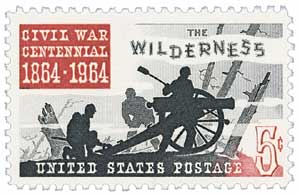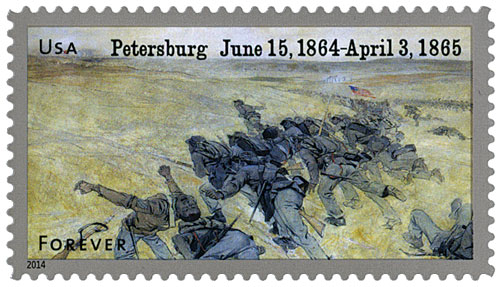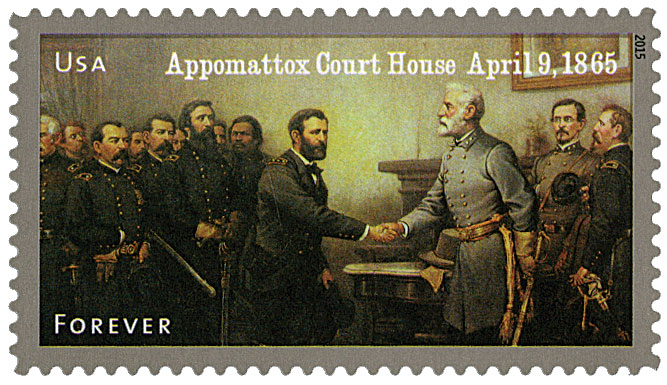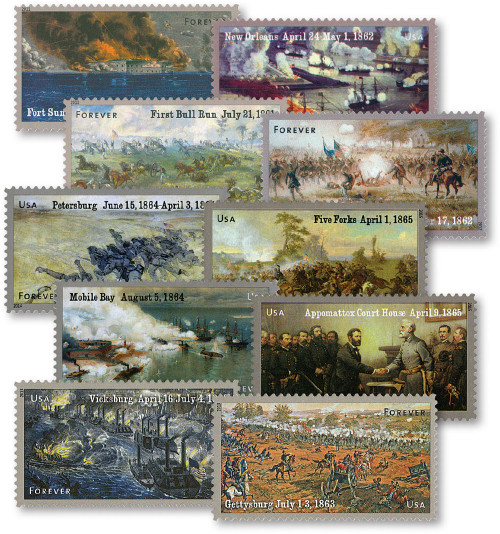
# 4981 - 2015 First-Class Forever Stamp - The Civil War Sesquicentennial, 1865: Surrender at Appomattox Court House
U.S. # 4981
2015 49¢ Surrender at Appomattox Courthouse
Civil War: 1865
General Of The Army Rank Created For Ulysses S. Grant

On July 25, 1866, Ulysses S. Grant became the first man to achieve the 4-star rank of General of the Army.
Nothing in Grant’s early life predicted his eventual success. Grant’s father arranged a West Point appointment for his son, who did not want to be a soldier. Grant was an indifferent student, graduating 21st in a class of 39 in 1843. However, he was an expert horseman and set a high jump record that stood for 25 years. Grant served with distinction during the Mexican-American War and was twice honored for bravery. When the war ended in 1848, Grant married Julia Boggs Dent, the daughter of a slave owner. He remained in the army until 1854, when he abruptly resigned.

Grant struggled through seven lean years as a farmer before going to work in his father’s Galena, Illinois, tannery. He reportedly favored Democrat Stephen Douglas over Lincoln in the 1860 presidential election but did not cast a vote. Lincoln’s election would soon change the course of Grant’s life.
When Lincoln called for 75,000 volunteers following the fall of Fort Sumter, Grant recruited a company and traveled with it to Springfield, Illinois. He became known as a “man of dogged persistence and iron will” and was quickly given charge of the District of Cairo, located where the Ohio River empties into the Mississippi in the southernmost part of Illinois.

Across the river, Confederate General Leonidas Polk assembled his army in Columbus, Kentucky. Ordered to attack Polk’s troops, Grant crossed the river with 3,114 men and briefly seized Fort Belmont. Although driven back and defeated, Grant’s confidence increased and his reputation grew after the Battle of Belmont. He then captured Fort Donelson in what was the biggest Union victory of the war to date, earning nationwide recognition and the rank of major general.
Victory at the Battle of Shiloh jeopardized Grant’s reputation. The two-day battle, which allowed the two Union armies to join in Tennessee, was the costliest in American history at the time with 23,746 total casualties. Both sides were shocked by the carnage.

Greater victory came in the Vicksburg Campaign, which gave Union forces control of the entire Mississippi River and divided the Confederacy in two. That success was followed by the Battle of Chattanooga, opening the heartland of the Confederacy to Union invasion. By late fall of 1863, Grant was placed in charge of the entire Union Army and relocated to Washington, D.C., where he worked directly with Lincoln to devise a final strategy to end the conflict.
The Overland Campaign was a battle of attrition – a total war of devastation designed to break the South. Union armies targeted Confederate troops, railroads, and Southern economic infrastructures. Meanwhile, Robert E. Lee tried to prolong the war, discourage Northerners tired of war, and protect the Confederate capital from Union attack. Rather than retreat as his predecessors had, Grant pursued Lee and fought his troops at the Wilderness, Cold Harbor, and Petersburg.

During Grant’s Petersburg campaign, Sherman took Atlanta and Sheridan prevented Confederate General Early from taking Washington, D.C. By spring of 1865, Grant’s dogged determination had the Confederate army scattered and defeated. On April 9, 1865, Robert E. Lee surrendered to Grant at Appomattox.
Grant returned to Washington, D.C., on April 13th. That evening, he and Lincoln rode through the nation’s capital, which was lit in celebration of Lee’s surrender. The men were cheered at every corner. The following day, Grant accepted an invitation to attend a play at Ford’s Theater with the president and Mrs. Lincoln. However, the relationship between Julia Grant and Mary Todd Lincoln was strained. Grant offered his apologies, claiming Julia wanted to visit their children in New Jersey, and left the capital by train.

A message was handed to Grant during a stop in Philadelphia. “The President was assassinated at Ford’s Theater at 10:30 tonight and cannot live.” A man tried to force his way into the Grant’s railroad car that evening, and a note indicated the couple was also the target of a failed assassination plot. Following Lincoln’s funeral, which Grant personally arranged, the Union general became the most popular man in the U.S.
In recognition of Grant’s victories during the war, Congress created an entirely new rank for him on July 25, 1866 – the four-star General of the Army of the United States. Click here to read the order from the Secretary of War. Over the next 20 years, only one man at a time could hold the rank of General of the Army. When Grant became president, William T. Sherman succeeded him. Philip Sheridan followed Sherman briefly before the rank was abolished for 58 years. The modern General of the Army rank is not considered to be the same as the rank Grant once held.
Robert E. Lee’s situation was grim in April 1865. He commanded an army of just 60,000 starving men against a well-nourished Union force of 100,000. Lee lost half of those troops in a single week at the battles of Five Forks, Petersburg, and Sailor’s Creek. And two of his sons – both officers in the Confederate Army – were missing in action.
But Lee’s biggest challenge was Ulysses Grant, whose army had cut off his escape and encircled the Confederate troops at Virginia’s Appomattox Court House. Rather than destroy his army and sacrifice the lives of his men needlessly, Lee decided to surrender on April 9, 1865.
The surrender documents were signed in the afternoon. Grant ordered his men to refrain from celebrating and allowed the Confederates to return to their homes with their swords, horses, and mules in exchange for laying down their arms. As about 28,000 Southern soldiers passed by and stacked their guns, they were saluted by the Union troops.
Although some skirmishing continued, other Confederate generals soon surrendered their armies. Grant’s leniency at Appomattox helped establish a mood of forgiveness and reconciliation, putting an end to the nation’s long nightmare.
Designed by art director Phil Jordan, the Appomattox Court House stamp features the same format as previous issues in the series, including traditional artwork. The stamp pictures an 1895 painting by Thomas Nast titled Peace in Union.
Value: 49¢ 1-ounce first-class letter rate
Issued: April 9, 2015
First Day City: Appomattox, VA – the site of the Confederate surrender
Type of Stamp: Commemorative
Printed by: Banknote Corporation of America for Sennett Security Products
Method: Offset printed in double-sided sheets of 72 with six panes of 12 per sheet
Perforation: Serpentine Die Cut 11
Self-Adhesive
Quantity Printed: 5,400,000 stamps
The Appomattox stamp, along with the Five Forks stamp, comprised the final set in a five-year series commemorating the Civil War’s major battles. Each year, two significant battles from 150 years prior were honored with sheets similar to this one. Each sheet includes a wartime photo, quotes, and recap of the year’s events.
This was the second U.S. stamp to honor Appomattox, the other being U.S. #1182.
U.S. # 4981
2015 49¢ Surrender at Appomattox Courthouse
Civil War: 1865
General Of The Army Rank Created For Ulysses S. Grant

On July 25, 1866, Ulysses S. Grant became the first man to achieve the 4-star rank of General of the Army.
Nothing in Grant’s early life predicted his eventual success. Grant’s father arranged a West Point appointment for his son, who did not want to be a soldier. Grant was an indifferent student, graduating 21st in a class of 39 in 1843. However, he was an expert horseman and set a high jump record that stood for 25 years. Grant served with distinction during the Mexican-American War and was twice honored for bravery. When the war ended in 1848, Grant married Julia Boggs Dent, the daughter of a slave owner. He remained in the army until 1854, when he abruptly resigned.

Grant struggled through seven lean years as a farmer before going to work in his father’s Galena, Illinois, tannery. He reportedly favored Democrat Stephen Douglas over Lincoln in the 1860 presidential election but did not cast a vote. Lincoln’s election would soon change the course of Grant’s life.
When Lincoln called for 75,000 volunteers following the fall of Fort Sumter, Grant recruited a company and traveled with it to Springfield, Illinois. He became known as a “man of dogged persistence and iron will” and was quickly given charge of the District of Cairo, located where the Ohio River empties into the Mississippi in the southernmost part of Illinois.

Across the river, Confederate General Leonidas Polk assembled his army in Columbus, Kentucky. Ordered to attack Polk’s troops, Grant crossed the river with 3,114 men and briefly seized Fort Belmont. Although driven back and defeated, Grant’s confidence increased and his reputation grew after the Battle of Belmont. He then captured Fort Donelson in what was the biggest Union victory of the war to date, earning nationwide recognition and the rank of major general.
Victory at the Battle of Shiloh jeopardized Grant’s reputation. The two-day battle, which allowed the two Union armies to join in Tennessee, was the costliest in American history at the time with 23,746 total casualties. Both sides were shocked by the carnage.

Greater victory came in the Vicksburg Campaign, which gave Union forces control of the entire Mississippi River and divided the Confederacy in two. That success was followed by the Battle of Chattanooga, opening the heartland of the Confederacy to Union invasion. By late fall of 1863, Grant was placed in charge of the entire Union Army and relocated to Washington, D.C., where he worked directly with Lincoln to devise a final strategy to end the conflict.
The Overland Campaign was a battle of attrition – a total war of devastation designed to break the South. Union armies targeted Confederate troops, railroads, and Southern economic infrastructures. Meanwhile, Robert E. Lee tried to prolong the war, discourage Northerners tired of war, and protect the Confederate capital from Union attack. Rather than retreat as his predecessors had, Grant pursued Lee and fought his troops at the Wilderness, Cold Harbor, and Petersburg.

During Grant’s Petersburg campaign, Sherman took Atlanta and Sheridan prevented Confederate General Early from taking Washington, D.C. By spring of 1865, Grant’s dogged determination had the Confederate army scattered and defeated. On April 9, 1865, Robert E. Lee surrendered to Grant at Appomattox.
Grant returned to Washington, D.C., on April 13th. That evening, he and Lincoln rode through the nation’s capital, which was lit in celebration of Lee’s surrender. The men were cheered at every corner. The following day, Grant accepted an invitation to attend a play at Ford’s Theater with the president and Mrs. Lincoln. However, the relationship between Julia Grant and Mary Todd Lincoln was strained. Grant offered his apologies, claiming Julia wanted to visit their children in New Jersey, and left the capital by train.

A message was handed to Grant during a stop in Philadelphia. “The President was assassinated at Ford’s Theater at 10:30 tonight and cannot live.” A man tried to force his way into the Grant’s railroad car that evening, and a note indicated the couple was also the target of a failed assassination plot. Following Lincoln’s funeral, which Grant personally arranged, the Union general became the most popular man in the U.S.
In recognition of Grant’s victories during the war, Congress created an entirely new rank for him on July 25, 1866 – the four-star General of the Army of the United States. Click here to read the order from the Secretary of War. Over the next 20 years, only one man at a time could hold the rank of General of the Army. When Grant became president, William T. Sherman succeeded him. Philip Sheridan followed Sherman briefly before the rank was abolished for 58 years. The modern General of the Army rank is not considered to be the same as the rank Grant once held.
Robert E. Lee’s situation was grim in April 1865. He commanded an army of just 60,000 starving men against a well-nourished Union force of 100,000. Lee lost half of those troops in a single week at the battles of Five Forks, Petersburg, and Sailor’s Creek. And two of his sons – both officers in the Confederate Army – were missing in action.
But Lee’s biggest challenge was Ulysses Grant, whose army had cut off his escape and encircled the Confederate troops at Virginia’s Appomattox Court House. Rather than destroy his army and sacrifice the lives of his men needlessly, Lee decided to surrender on April 9, 1865.
The surrender documents were signed in the afternoon. Grant ordered his men to refrain from celebrating and allowed the Confederates to return to their homes with their swords, horses, and mules in exchange for laying down their arms. As about 28,000 Southern soldiers passed by and stacked their guns, they were saluted by the Union troops.
Although some skirmishing continued, other Confederate generals soon surrendered their armies. Grant’s leniency at Appomattox helped establish a mood of forgiveness and reconciliation, putting an end to the nation’s long nightmare.
Designed by art director Phil Jordan, the Appomattox Court House stamp features the same format as previous issues in the series, including traditional artwork. The stamp pictures an 1895 painting by Thomas Nast titled Peace in Union.
Value: 49¢ 1-ounce first-class letter rate
Issued: April 9, 2015
First Day City: Appomattox, VA – the site of the Confederate surrender
Type of Stamp: Commemorative
Printed by: Banknote Corporation of America for Sennett Security Products
Method: Offset printed in double-sided sheets of 72 with six panes of 12 per sheet
Perforation: Serpentine Die Cut 11
Self-Adhesive
Quantity Printed: 5,400,000 stamps
The Appomattox stamp, along with the Five Forks stamp, comprised the final set in a five-year series commemorating the Civil War’s major battles. Each year, two significant battles from 150 years prior were honored with sheets similar to this one. Each sheet includes a wartime photo, quotes, and recap of the year’s events.
This was the second U.S. stamp to honor Appomattox, the other being U.S. #1182.






